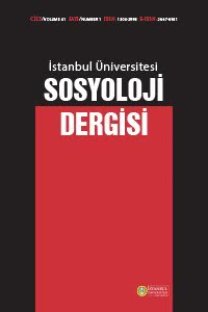Arnold, creswell ve grabar metinleri bağlamında islam sanatı ve oryantalist yaklaşımlar üzerine bir inceleme I
İslam’ın sanat konusundaki tutumu özellikle figüratif temsil/tasvir konusu,oryantalist sanat tarihçileri tarafından ikonoklazm ve anikonizm bağlamında tartışılırkenMüslüman dünyada teolojik bağlamda yasak ve gelenek çerçevesinde değerlendirilmiştir.Bu makale, Thomas Arnold, K. A. C. Creswell ve Oleg Grabar’ın kendi metodolojileriçerçevesinde, İslam sanatı ve İslam sanatında figüratif temsil/tasvir konusunda kalemealdıkları, konu ile ilgili temel metinler olarak kabul edilen makaleleri üzerinden yapılacakbir değerlendirmeyi kapsamaktadır. Söz konusu sanat tarihçilerinin metinlerinde İslamsanatı ve figüratif tasvir, şu başlıklar altında ele alınmıştır: İslam öncesi Arabistan’da sanat;fetihlerin, Hristiyan ve Yahudi sanatının İslam sanatına etkisi; İslam öncesi uygarlıklarınİslam sanatına etkisi; Kur’an ve hadisler ışığında sanata yaklaşım; erken İslam anıtlarındatasvir; İslam sanatında psikolojik etkiler.
A review on ıslamic art and orientalist approaches - I in the context of the articles by arnold, creswell and grabar
Orientalist art historians discussed Islam’s attitude towards art and especiallytowards figurative representation in the context of iconoclasm and aniconism, whereas theMuslim world assessed the matter with a theological perspective and in the scope of Islamicprohibitions and traditions. This paper is an evaluation of three articles by Thomas Arnold,K.A.C. Creswell and Oleg Grabar. Dealing with Islamic art and figurative representationin Islamic art, these articles, regarded as main sources of reference in this field, reflect themethodologies of the authors. In their articles these three art historians have dealt withIslamic art and figurative representation under the following chapters: Art in pre-IslamicArabia; the influence of conquests, Christian and Jewish art, and pre-Islamic civilizationson Islamic art; approaching art in the light of Quran and hadiths; representation in earlyIslamic monuments; psychological effects in Islamic art.
___
- Allen, T. (1988). Aniconism and figural representation in islamic art, Five essays on islamic art içinde (s. 17-38). Occidental (Kaliforniya): Solipsist Press. 16 Ocak 2012, http://sonic.net/~tallen/palmtree/fe2.htm
- Al-Faruqi, I. (1989). Figurative representation and drama: Their prohibi tion and transfiguration in Islamic art. Proceedings of the international symposium içinde (İstanbul, 1984), Islamic art: Common principles, forms and themes. Şam: Dar al-Fikr.
- Arnold, S. T. W. (1965). Painting in Islam. New York: Dover.
- Arnold, S. T. W. (1930). İslam dünyasında resmin menşeleri. H. Ömer (Çev.). Darülfunun İlahiyat Fakültesi Mecmuası. İstanbul: Evkaf Matbaası, 1-19.
- Belting, H. (2008). Florenz und Bagdad: Eine westöstliche Geschichte des Blicks, Münih: C. H. Beck Verlag.
- Bruckstein-Çoruh, A. S. ve Budde, H. (Ed.) (2009). Taswir: Islamische Bildwelten und Moderne (Pictorial Mappings of Islam and Modernity). Berlin.
- Çoban, B. Z. (2008). Bizans ikonoklazmının nedenleri ve islam etkisi tartışması. Dinbilimleri Akademik Araştırma Dergisi, VIII (4), 118-145.
- Creswell, K. A. C., (2002). The lawfulness of painting in early Islam. In J. M. Bloom (Ed.). Early Islamic Art and Architecture (s. 101-109), Burlington: Ashgate.
- Cruikshand, E. D. (2007). The image of the world: Notes on the religions iconography of Islam. Eva R. Hoffman (Ed.) Late Antique and Mediavel art of the Mediterranean world içinde (s. 185-213). Wiley-Blackwell Publishing.
- Grabar, O. (1973). The formation of Islamic art. New Haven: Yale University.
- Grabar, O. (1977). Islam and iconoclasm. A. Bryer ve J. Herrin (Ed.) Iconoclasm, early Islamic art 650-1100, Volume I içinde (s. 43-56). Birmingham.
- Grabar, O. (1998). İslam’ın sanat konusundaki tutumu. N. Yavuz (Çev.). İslam sanatının oluşumu içinde (s. 82-106). İstanbul: Yapı Kredi Yayınları.
- Heidemann, S. (2010). The evolving representation of the early Islamic empire and its religion on coin imagery. A. Neuwirth, N. Sinai ve M. Michael Marx (Ed.), The Qur’an in Context: Historical and Literary Investigations Into The Qurʾanic Milieu (Text and Studies on the Qur’an 6) içinde (s. 145-195). Boston: Leiden.
- Lammens, H. (1915). L’attitude de l’Islam primitif en face des arts figurés. Journal Asitique. Iıme Series, IV, 239-279.
- Naef, S. (2004). Bilder und Bilderverbot im Islam: Vom Koran bis zum Karikaturstreit (Y-a-t-il une “question de l’image en Islam?)
- Okasha, S. (1981). The prohobition of figurative art. In Islam, The Muslim painter and the divine - The persian impact on Islamic religious painting (s. 1-36). Londra: Park Lane.
- Papadopoulo, A. (1980). Islam and muslim art. R. E. Wolf (Çev.). Londra: Thames and Hudson.
- Paret, R. (1960). Textbelege zum islamischen Bildverbot. Das Werk des Künstlers: Studien zur Ikonographie und Formgeschichte içinde (s. 36- 48), Stuttgart: Festschrift Schrade.
- Soğancı, İ. Ö. (2004). Islamic aniconism: Making sense of a messy literature. Marilyn Zurmuehlen Working Papers in Art Education. Yıl: 2004, Sayı: 1, Makale: 4. 12 Ocak 2012, http://ir.uiowa.edu/mzwp/vol2004/iss1/4.
- Yetkin, S. K. (1952). İslam sanatının mahiyeti. A. Ü. İlahiyat Fakültesi Dergisi, 44-47.
- Yurdatapan, H. G. (1954). İslam resminin menşeleri ve başlangıçları. Ankara Üniversitesi İlahiyat Fakültesi Dergisi, III (3-4), 31-55.
- ISSN: 1304-2998
- Başlangıç: 2020
- Yayıncı: İstanbul Üniv. Edebiyat Fak. Sosyoloji Böl.
